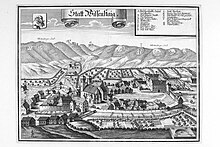Wiesensteig Monastery
Wiesensteig Monastery was initially a Benedictine monastery in Wiesensteig ( Göppingen district , Baden-Württemberg ) from the 9th to the 12th century . It was then converted into a collegiate monastery that existed until secularization in 1803.
The monastery and the monastery carried the patronage of Cyriacus , which the former monastery and today's parish church of St. Cyriacus still holds today.
history
Benedictine monastery
The foundation letter from the year 861, in which the monastery is mentioned for the first time, has only survived in two unauthorized copies from the 16th and 17th centuries and was suspected of being forgery for a long time. However, its content is now considered plausible because the Wiesensteiger Founding Convention named in the deed also appears a little later in an entry in the Reichenau monastery memorial book .
According to this document, apparently issued on the occasion of the consecration of the monastery church by the Bishop of Constance Salomon , the nobleman Rudolf and his son Erich founded the monastery at the request of King Ludwig the German . There has often been speculation about the family classification of the founders, but what is certain is that they were closely related to the East Franconian kingdom. In addition, the certificate mentions a concentrated endowment around Wiesensteig. Remote ownership is proven in Weinheim an der Bergstrasse . The first time here in Alamannia occupied Cyriacus - patronage could therefore adjacent on the Weinheim Lorsch Abbey , which was wealthy beyond in many places of the founding equipment Wies sidewalk, and the Wormser Cyriakus pen have been taught.
On a larger scale, the establishment (as well as that of the nearby Faurndau Abbey ) probably served the lordly penetration of northern Alamannia, which in contrast to the south, in particular the Lake Constance area with the large imperial monasteries of St. Gallen and Reichenau, was less at that time was developed.
100 years later, Wiesensteig is one of the monasteries owned by the Augsburg bishop Ulrich . Most likely, the monastery did not come to the diocese as inheritance from the founding family, but as a royal fiefdom in the middle of the 10th century.
Abbots known by name
- Tutaman, 861
- Ratpot, around 865
Kollegiatstift
It is unclear when the Benedictine monastery was converted into a collegiate monastery. The first provost of the abbey was documented in 1130 . Since the connection to the diocese of Augsburg remained until the end of the Old Kingdom - for example, the Wiesensteiger provosts were members of the cathedral chapter - the Augsburg bishop is likely to have been one of the initiators of this conversion. The specific reason could have been destruction in the course of the investiture dispute .
buildings
There are no structural findings from the Benedictine period. It is unclear whether the Romanesque parts of today's St. Cyriakus Collegiate Church ( crypt , substructure of the west towers) were built in the monastic period or not until the monastery period.
literature
- Hansmartin Schwarzmaier : Wiesensteig . In: Historical section of the Bavarian Benedictine Academy (ed.): The Benedictine monasteries in Baden-Württemberg (= Germania Benedictina ). 2nd edition, unchanged reprint. tape V . EOS Verlag, St. Ottilien 1987, ISBN 978-3-88096-605-5 , p. 670-673 .
- Hansmartin Schwarzmaier: About the beginnings of the Wiesensteig monastery . In: Journal for Württemberg State History . tape 18 , 1959, p. 217–232 ( mgh-bibliothek.de [PDF; accessed on August 19, 2019]).
Web links
- Wiesensteig monastery and collegiate monastery in the database of monasteries in Baden-Württemberg of the Baden-Württemberg State Archives
Individual evidence
- ↑ Wirtemberg document book . Volume I, no. 136. Stuttgart 1849, pp. 159–161 ( digitized , online edition )
